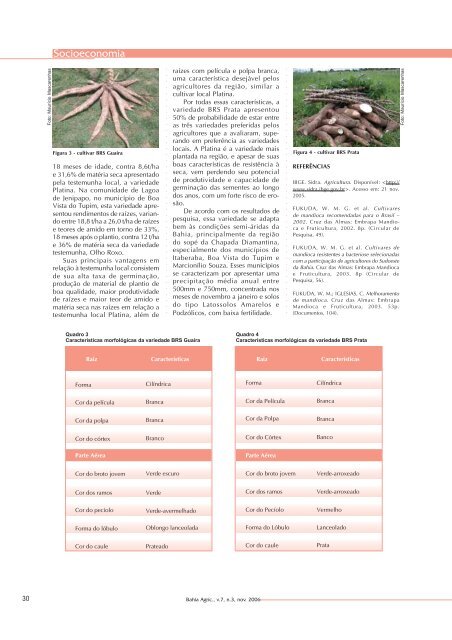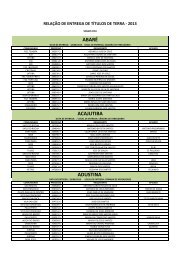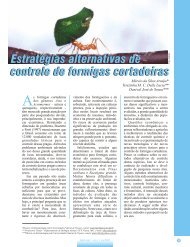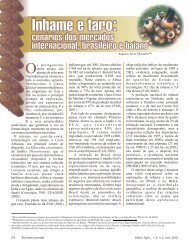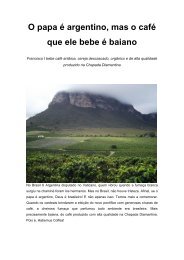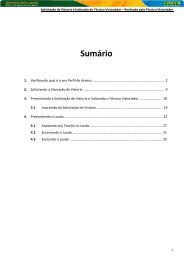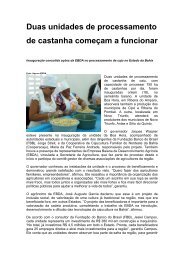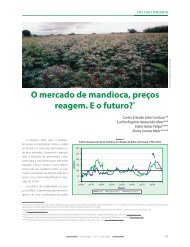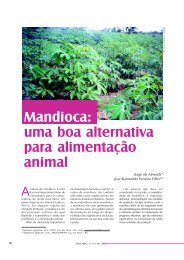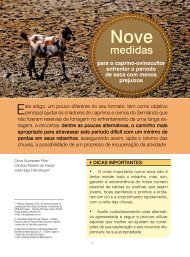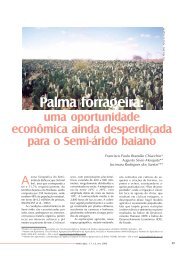Variedades de mandioca recomendadas para o Estado da ... - Seagri
Variedades de mandioca recomendadas para o Estado da ... - Seagri
Variedades de mandioca recomendadas para o Estado da ... - Seagri
Create successful ePaper yourself
Turn your PDF publications into a flip-book with our unique Google optimized e-Paper software.
30<br />
Foto: Maurício Mascarenhas<br />
Socioeconomia<br />
Figura 3 - cultivar BRS Guaíra<br />
18 meses <strong>de</strong> i<strong>da</strong><strong>de</strong>, contra 8,6t/ha<br />
e 31,6% <strong>de</strong> matéria seca apresentado<br />
pela testemunha local, a varie<strong>da</strong><strong>de</strong><br />
Platina. Na comuni<strong>da</strong><strong>de</strong> <strong>de</strong> Lagoa<br />
<strong>de</strong> Jenipapo, no município <strong>de</strong> Boa<br />
Vista do Tupim, esta varie<strong>da</strong><strong>de</strong> apresentou<br />
rendimentos <strong>de</strong> raízes, variando<br />
entre 18,8 t/ha a 26,0 t/ha <strong>de</strong> raízes<br />
e teores <strong>de</strong> amido em torno <strong>de</strong> 33%,<br />
18 meses após o plantio, contra 12 t/ha<br />
e 36% <strong>de</strong> matéria seca <strong>da</strong> varie<strong>da</strong><strong>de</strong><br />
testemunha, Olho Roxo.<br />
Suas principais vantagens em<br />
relação à testemunha local consistem<br />
<strong>de</strong> sua alta taxa <strong>de</strong> germinação,<br />
produção <strong>de</strong> material <strong>de</strong> plantio <strong>de</strong><br />
boa quali<strong>da</strong><strong>de</strong>, maior produtivi<strong>da</strong><strong>de</strong><br />
<strong>de</strong> raízes e maior teor <strong>de</strong> amido e<br />
matéria seca nas raízes em relação a<br />
testemunha local Platina, além <strong>de</strong><br />
○ ○ ○ ○ ○ ○ ○ ○ ○ ○ ○ ○ ○ ○ ○ ○ ○ ○ ○ ○ ○ ○ ○ ○ ○ ○ ○ ○ ○ ○ ○ ○ ○ ○ ○ ○ ○ ○ ○ ○ ○ ○ ○ ○ ○ ○ ○ ○ ○ ○ ○ ○ ○ ○ ○ ○ ○ ○ ○ ○ ○ ○ ○ ○ ○ ○ ○ ○ ○ ○ ○ ○ ○ ○ ○ ○ ○ ○ ○ ○<br />
raízes com película e polpa branca,<br />
uma característica <strong>de</strong>sejável pelos<br />
agricultores <strong>da</strong> região, similar a<br />
cultivar local Platina.<br />
Por to<strong>da</strong>s essas características, a<br />
varie<strong>da</strong><strong>de</strong> BRS Prata apresentou<br />
50% <strong>de</strong> probabili<strong>da</strong><strong>de</strong> <strong>de</strong> estar entre<br />
as três varie<strong>da</strong><strong>de</strong>s preferi<strong>da</strong>s pelos<br />
agricultores que a avaliaram, superando<br />
em preferência as varie<strong>da</strong><strong>de</strong>s<br />
locais. A Platina é a varie<strong>da</strong><strong>de</strong> mais<br />
planta<strong>da</strong> na região, e apesar <strong>de</strong> suas<br />
boas características <strong>de</strong> resistência à<br />
seca, vem per<strong>de</strong>ndo seu potencial<br />
<strong>de</strong> produtivi<strong>da</strong><strong>de</strong> e capaci<strong>da</strong><strong>de</strong> <strong>de</strong><br />
germinação <strong>da</strong>s sementes ao longo<br />
dos anos, com um forte risco <strong>de</strong> erosão.<br />
De acordo com os resultados <strong>de</strong><br />
pesquisa, essa varie<strong>da</strong><strong>de</strong> se a<strong>da</strong>pta<br />
bem às condições semi-ári<strong>da</strong>s <strong>da</strong><br />
Bahia, principalmente <strong>da</strong> região<br />
do sopé <strong>da</strong> Chapa<strong>da</strong> Diamantina,<br />
especialmente dos municípios <strong>de</strong><br />
Itaberaba, Boa Vista do Tupim e<br />
Marcionílio Souza. Esses municípios<br />
se caracterizam por apresentar uma<br />
precipitação média anual entre<br />
500mm e 750mm, concentra<strong>da</strong> nos<br />
meses <strong>de</strong> novembro a janeiro e solos<br />
do tipo Latossolos Amarelos e<br />
Podzólicos, com baixa fertili<strong>da</strong><strong>de</strong>.<br />
Bahia Agríc., v.7, n.3, nov. 2006<br />
○ ○ ○ ○ ○ ○ ○ ○ ○ ○ ○ ○ ○ ○ ○ ○ ○ ○ ○ ○ ○ ○ ○ ○ ○ ○ ○ ○ ○ ○ ○ ○ ○ ○ ○ ○ ○ ○ ○ ○ ○ ○ ○ ○ ○ ○ ○ ○ ○ ○ ○ ○ ○ ○ ○ ○ ○ ○ ○ ○ ○ ○ ○ ○ ○ ○ ○ ○ ○ ○ ○ ○ ○ ○ ○ ○ ○ ○ ○ ○<br />
Figura 4 - cultivar BRS Prata<br />
REFERÊNCIAS<br />
IBGE. Sidra. Agricultura. Disponível: . Acesso em: 21 nov.<br />
2005.<br />
FUKUDA, W. M. G. et al. Cultivares<br />
<strong>de</strong> <strong>mandioca</strong> <strong>recomen<strong>da</strong><strong>da</strong>s</strong> <strong>para</strong> o Brasil –<br />
2002. Cruz <strong>da</strong>s Almas: Embrapa Mandioca<br />
e Fruticultura, 2002. 8p. (Circular <strong>de</strong><br />
Pesquisa, 49).<br />
FUKUDA, W. M. G. et al. Cultivares <strong>de</strong><br />
<strong>mandioca</strong> resistentes a bacteriose seleciona<strong>da</strong>s<br />
com a participação <strong>de</strong> agricultores do Sudoeste<br />
<strong>da</strong> Bahia. Cruz <strong>da</strong>s Almas: Embrapa Mandioca<br />
e Fruticultura, 2003. 8p (Circular <strong>de</strong><br />
Pesquisa, 56).<br />
FUKUDA, W. M.; IGLESIAS, C. Melhoramento<br />
<strong>de</strong> <strong>mandioca</strong>. Cruz <strong>da</strong>s Almas: Embrapa<br />
Mandioca e Fruticultura, 2003. 53p.<br />
(Documentos, 104).<br />
Foto: Maurício Mascarenhas


